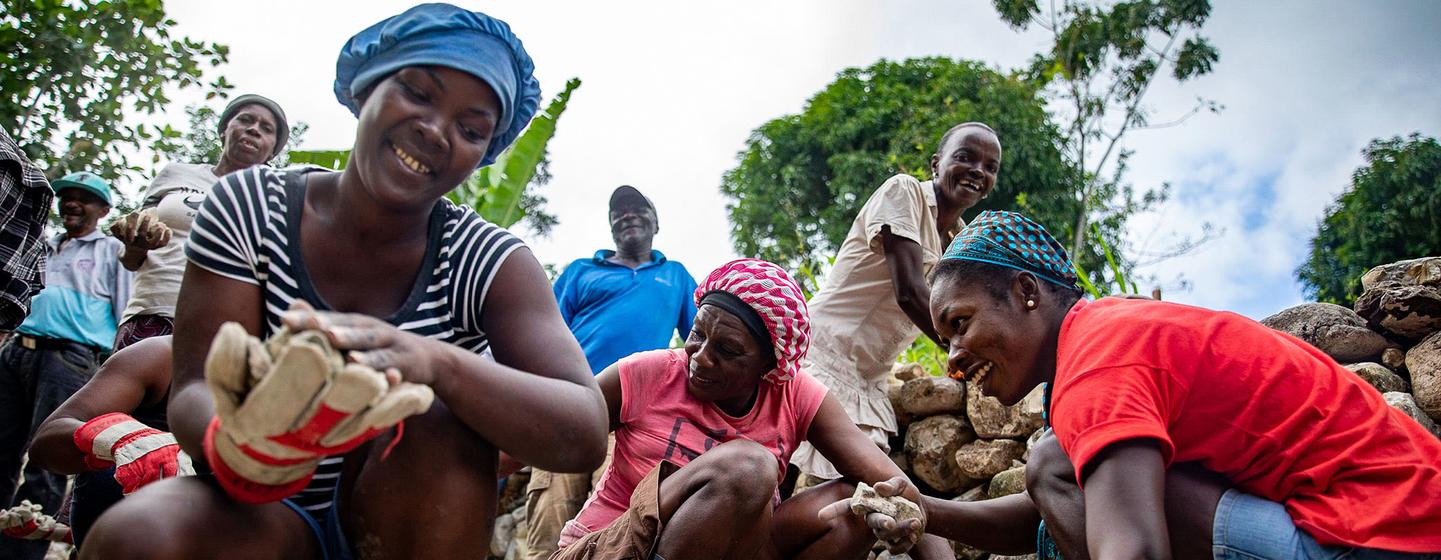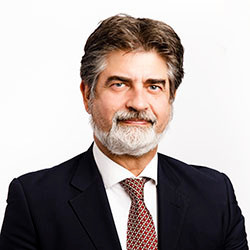Changing the narrative on Haiti
IFAD Asset Request Portlet
Asset Publisher
Changing the narrative on Haiti
Estimated reading time: 3 minutes
Women join a community effort to rehabilitate earthquake-damaged roads in the south-west of Haiti.
Paolo Silveri is IFAD’s Country Director for Haiti.
Last year, a 7.2-magnitude earthquake caused more than 2,200 deaths and US$2 billion worth of damage in southern Haiti. In February 2022, a Donors' Conference was held to seek financial and political support for the reconstruction and relaunch of the region. Despite the scale of the damage and Haitians’ urgent need for support, the conference went largely unnoticed by international media, which is dominated by crises that are considered more prominent. Yet, increased support is bound to make a substantial difference in the lives of many Haitians between now and 2025.
At the turn of the 19th century, Haiti became the first independent state in the Latin America and the Caribbean region. Since then, it has been dogged by political instability and a series of major natural disasters. It is among the 13 most fragile states in the world, and is the only country in the region with low human development. The terrifying earthquake in January 2010 that killed more than 300,000 people is just one of many grim examples of how exposed the country is to natural shocks, while its buffering and response capacities remain among the poorest in the world.
In February 2021, I was appointed IFAD Country Director for Haiti at a particularly turbulent time in the nation’s history. The murder of President Jovenel Moïse in July 2021 had deepened the country’s ongoing political crisis, for which Haitians are still seeking a way out. Just weeks after the assassination, a violent earthquake struck this beleaguered country.
These events were followed by tropical storms, whose fury and frequency is increasingly exacerbated by climate change. This has further deteriorated a fragile economic, political and security situation, leading to fuel shortages and exacerbating civil unrest.
In these initial months as field-based Country Director, I asked myself, “how can IFAD substantively contribute to the collective effort to alleviate the immediate suffering of Haitians, while also offering long-lasting solutions to rural people and decent livelihoods to young people?”
For 45 years, IFAD has been working in Haiti to reduce poverty and improve the climate resilience of rural communities. In 2022, six ongoing and new projects will help achieve these aims:
- The PITAG programme, a joint effort with the Inter-American Development Bank and the Global Agriculture and Food Security Programme, is improving agricultural productivity and food security through technology, capacity-building, and adaptive research.
- The PURRACO project helps farmers increase staple food production in the three Haitian departments most affected by food insecurity.
- The AGRI-digitization programme helps 22 farmers’ and fishery organizations use digital communications and electronic transactions to increase their access to markets, services, and agricultural inputs.
- The forthcoming Innovatech Project will strengthen and consolidate access to technological, financial, and non-financial services for 32 farmers' organizations.
- The Inclusive Blue Economy Project aims to reduce poverty and strengthen the climate resilience of 40,000 people living in rural coastal communities in the North and Northeast of Haiti.
- The Project for Strengthening the Resilience of Vulnerable Farmers in the South Department, a joint investment with FAO and the Green Climate Fund, aims to strengthen the climate resilience of critical agricultural systems and value chains.
Guided and owned by local authorities, IFAD’s efforts are leading to increased investments in land and marine development. Within a global context that prioritizes humanitarian aid in reaction to events, IFAD instead focuses on inclusive, resilient and innovative economic initiatives that move away from relief-centred aid and towards sustainable development.
All too often, Haiti is portrayed as doomed and hopeless. Given the unthinkable challenges in their daily lives, many Haitians may agree with this depiction.
I believe we need to change this outlook. We need to concentrate on creating economic and social opportunities in rural areas, so that young Haitians have an alternative to migration, while those who have already left have a reason to return.
Changes like these don't happen overnight. They require hard work and persistence. But I’m beginning to see positive signs. For one, the Donors' Conference managed to mobilize US$600 million of new commitments despite multiplying demands and growing “donors’ fatigue”. IFAD has been, and will continue to be, an active contributor to this effort.
That’s why IFAD is here in Haiti: to work tirelessly with partners to build accessible, resilient, and inclusive opportunities for Haitians. We will keep doing this until rural transformation becomes visible and the world – but most importantly, Haitians themselves – reconsiders the country and its destiny. We won’t stop working until Haiti is no longer a country in despair but, against all odds, can finally bask in a new light of hope.
Publication date: 24 February 2022